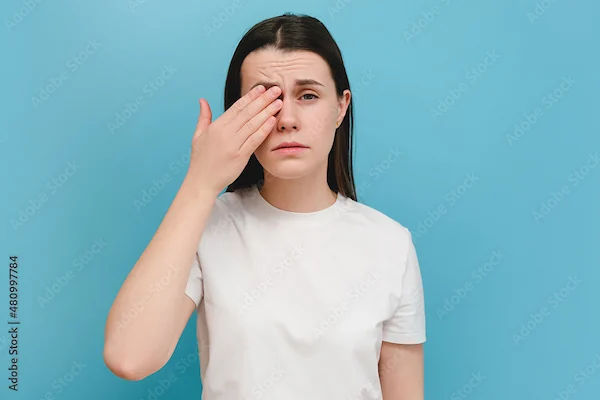Dry Eyes: Causes, Symptoms, Treatment
Dry eyes are a serious medical condition that causes eye discomfort and even it leads to vision loss. So, learn the causes and treatment options.

Written by
Last updated on 3rd Jul, 2025
Dry eyes are one of the common eye ailments and affect one's day-to-day activities from mild discomfort to serious pain. The condition involves either the eyes not making enough tears or tears evaporating too quickly, disturbing the protective tear film covering the eye's surface. The tear film has a vital role in providing the optical surface for vision, protecting against infection, and helping to maintain ocular health through the flushing of debris. So, it is essential to protect this layer to avoid inflammation, infection, and possible damage to the cornea. With proper diagnosis and treatment, it is possible to get relief and stop any permanent damage.
Causes of Dry Eyes
There are different causes of dry eyes and environmental factors are one of the primary ones. Usually, dry weather leads to this condition where the tears evaporate faster, resulting in dryness and irritation. Also, lifestyle habits like spending long hours in front of the computer and mobile phones can dry eyes, a condition called 'computer vision syndrome'. This phenomenon causes tears to evaporate faster, which causes discomfort.
Also, some medical conditions can cause dry eyes, such as autoimmune diseases, hormonal changes, and systemic conditions. For example:
Sjögren's Syndrome is an autoimmune disease that attacks the glands that retain body moisturiser and produce tears and saliva, resulting in severe dry eyes and mouth.
Elevated blood sugar levels can harm the nerves responsible for tear secretion, resulting in dry eyes.
An imbalance in thyroid hormones can also result in decreased tear production, leading to dry eyes.
Inflammation of the eyelids may reduce tear production and increase evaporation.
Some medications can lessen tear production, leading to dry eyes. These include:
Antihistamines commonly used to treat allergies can inhibit tear production and lead to dryness.
The medications used to treat depression and anxiety can reduce the production of tears.
Drop in hormone levels from birth control pills (a type of oral contraceptives) may also play a role in dry eyes.
Symptoms of Dry Eyes
Dry eyes affect everyone differently. Some may have a light case, while others suffer enough to make life impossible. The symptoms of dry eyes most commonly are:
Gritty or scratchy eyes
Burning or stinging sensation
Redness and irritation
Blurred vision
Fatigued eye
Watery eyes
In more severe cases, dry eyes can present further symptoms and complications, including:
Wearing contact lenses can be uncomfortable and even painful, mainly when the eyes are dry.
Dry eye can lead to conjunctiva inflammation, known as conjunctivitis.
The lack of moisture in the eyes due to the non-production of ample tears leads to various infections.
Corneal ulcers happen when an open sore develops on the cornea. Debris, such as dirt, gets stuck in the eyes and can't be removed because the gland can't produce enough tears. The debris creates scratches on the cornea that are infected by bacteria and cause ulcers.
Diagnosis of Dry Eyes
Visiting an eye care professional to diagnose a suspected dry eye condition is necessary. The doctor checks eye health during a standard physical examination and asks about the symptoms. They also inquire about the patient's medical history, lifestyle, and any medications that could contribute to dry eyes.
Then, several specialised tests can be used to diagnose dry eyes, including:
Schirmer Test: A small strip of paper is placed along the edge of the eyelids and leaves to measure tear production. If the paper becomes wet, it indicates healthy tear production, but a dry strip may suggest insufficient tears.
Tear Break-Up Time (TBUT): This test measures how long it takes for the tear film to break up on the eye's surface. A shorter TBUT, less than 10 seconds, may indicate dry eyes.
Osmolarity Test: This test measures the concentration of salts in tears, which can be elevated in individuals with dry eyes. An osmolarity value greater than 308 mOsm/L indicates dry eyes and tear dysfunction.
Treatment Options
Several treatment options are available to manage dry eyes, ranging from over-the-counter (OTC) solutions to more advanced therapies. OTC artificial tears and lubricating eye drops can temporarily relieve symptoms by supplementing the natural tear film for mild dry eyes. These products help moisturise the eyes, reduce irritation, and relieve symptoms.
In more serious cases, prescription medications and treatments can be required, including:
Anti-Inflammatory Eye Drops: Prescription eye drops like cyclosporine A (Restasis) can decrease eye inflammation and enhance tear production.
Punctual Plugs: These are small devices placed in the tear ducts to prevent tear drainage, keeping tears on the eye's surface for a longer time.
Thermal Pulsation Therapy: It becomes helpful for those who have unstable tear film due to meibomian gland dysfunction.
In some cases, steroid eye drops are also given to suppress inflammation and dry eye symptoms.
Apart from medications, lifestyle changes and home remedies can also help manage the condition. These include:
Taking Regular Breaks: Stepping away from screen time every 20 to 30 minutes can help prevent digital eye strain while keeping dry eyes at bay.
Using a Humidifier: Moisture in the air can help reduce tear evaporation, especially in dry or air-conditioned environments.
Warm Compresses: A warm compress can also promote oil production in the glands, leading to decreased dryness.
Good Eye Hygiene: Regularly cleaning the eyelids and eyelashes may help prevent and manage blepharitis, a possible cause of dry eyes.
Managing Dry Eyes with Diet
The diet also plays an integral part in managing dry eyes. Incorporating nutrients like omega-3 fatty acids, antioxidants, and vitamins supports eye health and mitigates inflammation.
Omega-3 Fatty Acids: Foods containing omega-3 fatty acids, such as salmon, flaxseeds, and walnuts, are essential for dry eyes. These foods help improve tear production and swelling in the eyes.
Antioxidants: Consuming antioxidant-rich foods, such as dark leafy greens, carrots, and bell peppers, benefits overall eye health.
Vitamin C: Citrus fruits such as oranges, lemons, and grapefruits contain vitamin C that improves vision.
Other supplements that can improve the quality of tears and help reduce dry eye symptoms are fish oil, vitamin A, and flaxseed oil.
Prevention of Dry Eyes
Dry eye prevention can be achieved by limiting exposure to environmental triggers and implementing new healthy habits into everyday life. These are –
Using a humidifier in dry weather
Wearing sunglasses to shield the eyes from the wind
Limiting the time spent in front of air conditioning
Avoid smoking
Blink regularly while staring at computers or books for a long duration
When to See a Doctor?
The individuals should contact a doctor in these cases –
If over-the-counter treatments have not relieved the dry eye symptoms or individuals are experiencing more intolerable symptoms such as pain and vision issues
If they suffer from intense pain, light sensitivity, or recurrent eye infections.
In case the dry eyes become chronic.
Conclusion
Dry eyes can significantly impact daily life, but relief is possible with proper diagnosis, treatment, and lifestyle adjustments. Managing environmental triggers, maintaining a healthy diet, and using appropriate eye care solutions can help prevent complications. However, if symptoms persist or worsen, consulting an eye care professional is essential to avoid long-term damage and ensure optimal eye health.
Consult Top Ophthalmologists
Consult Top Ophthalmologists

Dr. Dinesh Talwar
Ophthalmologist
32 Years • MBBS, MD
Delhi
Apollo Hospitals Indraprastha, Delhi

Dr. Shikha Fogla
Ophthalmologist
17 Years • MBBS; MS Ophthal, Fellow in Anterior Segment & Glaucoma
Hyderabad
Apollo Hospitals Jubilee Hills, Hyderabad
(50+ Patients)

Dr. Madhurjya Gogoi
Ophthalmologist
19 Years • MBBS, MD(AIIMS)
Guwahati
Apollo Excelcare Hospital, Guwahati

Dr. Sujit Pahari
Ophthalmologist
22 Years • MBBS, DNB, DOMS Ophthalmologist/ Eye Surgeon. FIC (Ophthal).
Bilaspur
Apollo Hospitals Seepat Road, Bilaspur

Dr. Siddharth Malaiya
Ophthalmologist
10 Years • MS Opthal,Cornea Transplant
Bhopal
Apollo Sage Hospitals, Bhopal
(25+ Patients)
